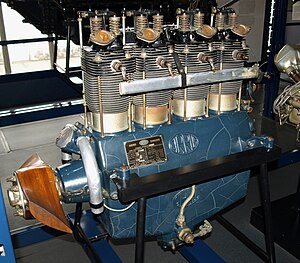ADC Cirrus
| Cirrus | |
|---|---|

| |
| ADC Cirrus II at the Science Museum, London | |
| Type | Air-cooled 4-cylinder inline piston engine |
| National origin | United Kingdom |
| Manufacturer | Aircraft Disposal Company, Cirrus Aero-Engines Limited |
| First run | Template:Avyear |
| Major applications | de Havilland DH.60 Moth Avro Avian |
The ADC Cirrus and Cirrus-Hermes are British aero engines of the mid-1920s. Sometimes known as the Blackburn Cirrus,[1] examples remain airworthy today.
Design and development
ADC Cirrus engines were originally built by ADC Aircraft until Cirrus Aero Engines Limited was formed in 1927. The company became Cirrus-Hermes in 1931 when it was bought by the Cirrus-Hermes Engineering Company and later became the Cirrus Engine Section of Blackburn & General Aircraft Limited in 1934, and operated as a separate division until production ended in the post-World War II era.[2]
Cirrus's first product was the 90 hp (67 kW) Cirrus I, which passed its 50-hour type rating in 1925. It was the first air-cooled inline engine, a design by Frank Halford that proved extremely popular for light aircraft. The basic layout (using one cylinder bank of an ADC Airdisco V-8 engine)[3] was quickly copied by a number of other manufacturers. Later versions named the Cirrus II, and Cirrus III were produced each with slightly greater displacement, and power (Cirrus II - 85 hp, Cirrus III - 90 hp).
The next model line, Cirrus-Hermes I, II, and IV were produced ranging in power from 105 hp to 140 hp depending on type. The later Cirrus engines were designed to run inverted.[4]
The Cirrus III was also produced/converted by American Cirrus Engines Inc., Belleville NJ (later A.C.E. Corp, Marysville MI.).
Variants


- Cirrus I
- (1925)
- Cirrus II
- (1926)
- Cirrus III
- (1929)
- Cirrus IIIA
- (1933)
- Cirrus-Hermes I
- (1929)
- Cirrus-Hermes II
- (1930)
- Cirrus-Hermes IIB (inverted)
- (1931)
- Cirrus-Hermes IV
- (1930)
- Cirrus-Hermes IVA
- (1929) Inverted engine
- American Cirrus III
- American Cirrus III Hi-drive
Applications
Cirrus
- Cirrus I
- Cirrus II
- Avro Avian
- de Havilland DH.60 Moth
- de Havilland DH.71 Tiger Moth
- Piaggio P.9
- Short Mussel
- Westland Widgeon
- Bloudek XV Lojze
- Cirrus III
- Avro Avian
- Blackburn Bluebird
- Cierva C.17
- de Havilland DH.60 Moth
- de Havilland DH.71 Tiger Moth
- Dudley Watt D.W.2
- Emsco B-4 Cirrus
- Koolhoven FK.41[7]
- Klemm L.26
- Klemm L.27
- Short Mussel
- Simmonds Spartan
- Spartan Arrow
- Westland Wessex
- Westland Widgeon
- Cirrus IIIA
Cirrus-Hermes
- Cirrus-Hermes I
- Avro Avian
- Blackburn Bluebird
- de Havilland DH.60 Moth
- Desoutter I
- Koolhoven FK.41[8]
- Koolhoven FK.42[9]
- Hawker Tomtit
- Hendy 302
- Parnall Elf
- Saro Cutty Sark
- Simmonds Spartan
- Southern Martlet
- Westland Wessex
- Westland Widgeon
- Cirrus-Hermes II
- Cirrus-Hermes IIB
- Cirrus-Hermes IV
- Avro Cadet
- Hendy 302
- Miles M.2 Hawk
- Percival Gull
- Roe IV Triplane replica
- Spartan Cruiser
- Spartan Three-Seater
- Cirrus-Hermes IVA
Engines on display

- A preserved ADC Cirrus II is on display at the Science Museum (London).
- A Cirrus Hermes is on display at the EAA AirVenture Museum in Oshkosh, Wisconsin.
Specifications (Cirrus I)

Data from Lumsden.[2]
General characteristics
- Type: Inline, air-cooled, upright 4-cylinder piston engine
- Bore: 4.13 in (105 mm)
- Stroke: 5.12 in (130 mm)
- Displacement: 274.36 cu in (4.5 L)
- Length: 45.8 in (116.3 cm)
- Width: 18.26 in (46.4 cm)
- Height: 34.3 in (87.1 cm)
- Dry weight: lb ( kg)
Components
- Valvetrain: 1 inlet and 1 exhaust valve per cylinder
- Fuel system: 1 Claudel carburettor
- Fuel type: 70 octane
- Cooling system: air
Performance
- Power output: 60 hp (45 kW)
- Compression ratio: 4.7:1
See also
Related development
Comparable engines
Related lists
References
Notes
- ^ This name applies only to the revised range of Cirrus engines produced after 1934 by Blackburn, e.g. the Blackburn Cirrus Major.
- ^ a b Lumsden 2003, p. 130.
- ^ Gunston 1989, p. 40.
- ^ Lumsden 2003, p.132.
- ^ Lumsden 2003, pp. 130-132.
- ^ Cirrus engines may not be the main powerplant for these aircraft types (test installations are included).
- ^ Jackson p.190 1973
- ^ Jackson p.495 1973
- ^ Les Ailes 469, p.3 1930
- ^ Wesselink 1982 p.80
- ^ Wesselink 1982 p.81
Bibliography
- Gunston, Bill. World Encyclopaedia of Aero Engines. Cambridge, England. Patrick Stephens Limited, 1989. ISBN 1-85260-163-9
- Lumsden, Alec. British Piston Engines and their Aircraft. Marlborough, Wiltshire: Airlife Publishing, 2003. ISBN 1-85310-294-6.
- Jackson, A.J. (1973). British Civil Aircraft 1919-72. Vol. 2. London: Putnam Publishing. ISBN 0 85177 813 5.
- Frachet, André (12 June 1930). "Le monoplan Koolhoven F.K.42". Les Ailes (469): 3.
- Wesselink, Theo; Postma, Thijs (1982). De Nederlandse vliegtuigen. Haarlem: Romem. ISBN 90 228 3792 0.
